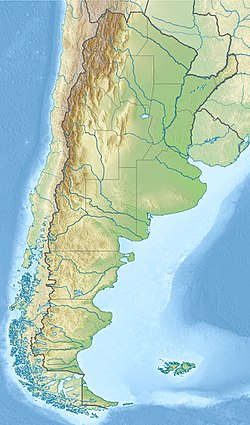Laguna Palacios Formation
| Laguna Palacios Formation | |
|---|---|
| Stratigraphic range: Maastrichtian | |
| Type | Geological formation |
| Unit of | Chubut Group |
| Underlies | Río Chico Group (Salamanca Formation) |
| Overlies | Lago Colhué Huapí Formation |
| Lithology | |
| Primary | Tuff |
| Location | |
| Coordinates | 44°53′38″S 69°23′01″W / 44.89389°S 69.38361°W |
| Region | Central Patagonia |
| Country | Argentina |
| Extent | Golfo San Jorge Basin |
| Type section | |
| Named for | Laguna Palacios |
| Named by | Bonaparte |
| Year defined | 1978 |
The Laguna Palacios Formation is a Maastrichtian geologic formation of the Chubut Group in the Golfo San Jorge Basin in Patagonia, Argentina. The formation partly overlies and partly is laterally equivalent to the Lago Colhué Huapí Formation and is overlain by the Salamanca Formation of the Río Chico Group.[1] The formation comprises tuff reworked by fluvial activity and paleosols. The Laguna Palacios Formation has provided fossilized bee nests.[2]
Environment
[edit]Primary deposits of the Lagunas Palacios Formation consist of massive sheet beds of vitric and crystal tuffs and chonites, tuffaceous mudstones and claystones with moderate bioturbation and pedified tops. Subordinate fine to medium grained sandstones are in incised lenticular or channel beds with erosive bases. Scarce fine conglomerates appear as channel fills. Modified facies are paleosols originating in aeolian ash and sand substrate. These record root traces, waterlogging, desiccation cracks, and in situ fossil tree stumps. The sedimentary scenario was similar to the loess plains with few rivers and ponds. Pyroclastics supplied as distal ash fallout were pedified by subordinated fluvial streams. This environment was comparable to the Pleistocene-Holocene loess Pampean Plain. Paleosols ranged from entisols to andosols and alfisosols/mollisols, representing a temperate subhumid-seasonal climate in a grass-covered landscape. Halictin bee nests and Coelopteran pupal chambers have been found in this formation, with the nests being some of the earliest evidence for eusociality in bees.[3][4]
See also
[edit]References
[edit]- ^ Casal et al., 2015, p.90
- ^ Genise et al., 2002
- ^ Bellosi1 Sciutto2, Eduardo1 Juan C.2 (January 2002). "Laguna Palacios Formation (San Jorge Basin, Argentina): an Upper Cretaceous loess-paleosol sequence from Central Patagonia". Argentine Meeting on Sedimentology – via ResearchGate.
{{cite journal}}: CS1 maint: numeric names: authors list (link) - ^ Genise, Jorge F.; Sciutto, Juan C.; Laza, José H.; González, Mirta G.; Bellosi, Eduardo S. (2002-01-15). "Fossil bee nests, coleopteran pupal chambers and tuffaceous paleosols from the Late Cretaceous Laguna Palacios Formation, Central Patagonia (Argentina)". Palaeogeography, Palaeoclimatology, Palaeoecology. 177 (3): 215–235. doi:10.1016/S0031-0182(01)00333-9. ISSN 0031-0182.
Bibliography
[edit]- Casal, Gabriel A.; Allard, José O.; Foix, Nicolás (2015), "Análisis estratigráfico y paleontológico del Cretácico Superior en la Cuenca del Golfo San Jorge: Nueva unidad litoestratigráfica para el Grupo Chubut", Revista de la Asociación Geológica Argentina, 72: 77–95, hdl:11336/111016, retrieved 2019-02-16
- Genise, J.F.; Sciutto, J.C.; Laza, J.H.; González, M.A. (2002), "Fossil bee nests, coleopteran pupal chambers and tuffaceous paleosols from the Late Cretaceous Laguna Palacios Formation, Central Patagonia (Argentina)", Palaeogeography, Palaeoclimatology, Palaeoecology, 177 (3–4): 215–235, Bibcode:2002PPP...177..215G, doi:10.1016/S0031-0182(01)00333-9, retrieved 2019-02-16
- Weishampel, David B.; Dodson, Peter; Osmólska, Halszka (2004), The Dinosauria, 2nd edition, Berkeley: University of California Press, pp. 1–880, ISBN 0-520-24209-2, retrieved 2019-02-21

